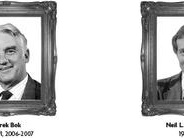“I have the feeling that if I needed to talk to her, that I could get in and talk to her,” said Gary Urton, chair of the anthropology department. “And I feel that she would listen.”
Faust’s penchant for translating voices from across the community into University programming is especially notable when contrasted with the style of her predecessor, who was known for bold visions that did not necessarily attain consensus support.
“Summers led by confronting the faculty and community with his views,” Bhabha said. “He led from the front so to speak.”
In contrast, Bhabha described Faust as someone who “sees leadership as something whereby she is careful to pull the whole faculty with her.”
A NEW PUSH
With the Summers presidency in the University’s rearview mirror, and the financial crisis nearly past, the attention of Harvard’s central administration has taken a dramatic turn from dealing with financial meltdown to embarking on what many predict will be the biggest capital campaign ever by an institution of higher education.
Until now, events have shaped the Faust presidency. But the campaign’s September launch will force her to take control of them. In leading Harvard through a record-breaking drive, Faust’s ability to communicate with faculty and donors alike will undoubtedly be key.
“Nobody can take the place of a president in delivering a message as to why you should give money. Harvard has that president,” said John A. Kaneb ’56, a prominent donor who also serves on Harvard Medical School’s Board of Fellows. “[Faust has] a god-given ability to put people at ease without even trying—she does naturally. I’ve seen her do it. She did it to me.”
But Faust’s job will extend beyond communicating as the campaign challenges her to inspire donors with the specifics of a more-than-decade-old vision applied to today’s Harvard.
“I think that on the one hand, one hopes that her vision and her leadership will lead to the kind of support that’s necessary for the campaign,” Malkin said. “And on the other hand, the degree to which the campaign is successful—rightly or wrongly—will have a large measure in the evaluation of how successful she has been.”
Faust’s approach to the campaign, like her approach to her presidency, has relied on themes of the past.
According to long-time donor and venture capitalist Sidney R. Knafel ’52, the one university concept also drove Harvard’s last campaign, headed by Rudenstine in the 1990s. The campaign, which was Harvard’s first University-wide campaign, raised a total $2.6 billion—a massive sum at the time.
“[The upcoming campaign] isn’t the first effort to present Harvard as one university,” Knafel said, adding that the he predicts The Harvard Campaign will be more successful in that regard than the 1990s drive.
Still, he said, “They wouldn’t be functioning as collaboratively and collegiately [now] as they are if they hadn’t gone through the training ground of that [1990s] campaign.”
Building on this foundation, Faust must adjust the broad vision of unification to today’s world. Some of her announced initiatives include the School of Engineering and Applied Sciences’ move across the river to Allston and funding HarvardX, Harvard’s branch of the virtual learning initiative edX that brings online courses to anyone in the world for free.
Read more in University News
Canada Tells HKS It Is Time To Pass the Baton













